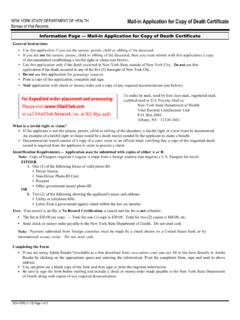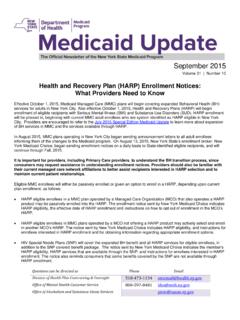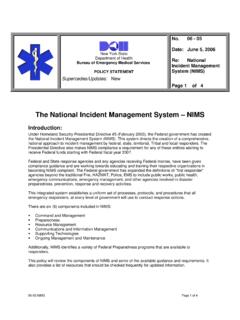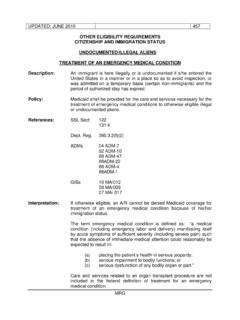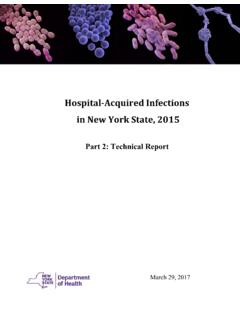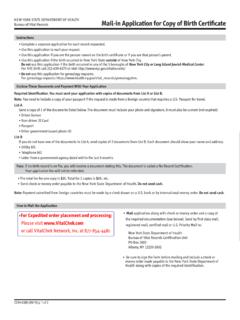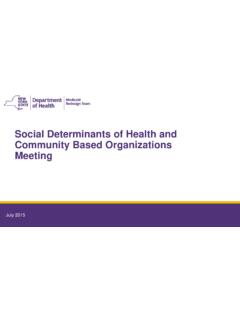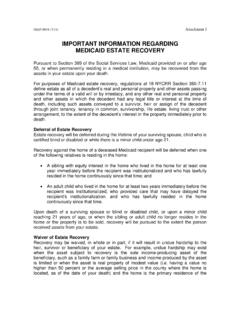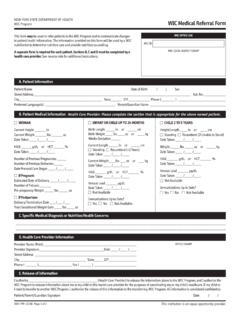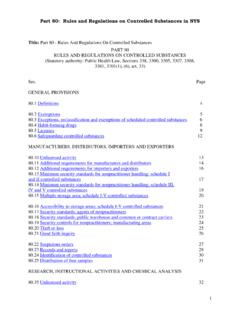Transcription of TABLE OF CONTENTS - New York State Department of …
1 TABLE OF CONTENTS . PART 16 - IONIZING RADIATION. (Statutory authority: Public Health Law, Section 225). Introductory note .. 1. general provisions .. 2. Applicability and inapplicability of this Part .. 2. 2. Granting exemptions or variations .. 20. Exemption of certain radiation sources from the requirements of this Part .. 20. Responsibility for radiation safety .. 20. Occupational dose limits .. 21. Radiation dose limits for individual members of the public .. 27. Waste disposal .. 28. Professional practitioners and related provisions .. 28. Inspections, surveys, checks and tests; vacating installations; securing sources .. 29. Personnel monitoring .. 31. Radiation symbol, signs, labels, and control 33. Notices, instructions and reports to workers; 39. Records .. 44. Reports .. 47. Procedures for picking up, receiving, and opening packages .. 51. Transportation .. 52. Additional requirements; surrender of radioactive material; sealing of equipment .. 53.
2 Limitations on application of radiation to humans .. 54. Hearings .. 55. Reserved.. 55. X-ray screening; general requirements; mammography .. 55. Quality assurance programs for diagnostic facilities .. 57. Quality assurance programs for the use of radiation for therapy in humans .. 59. 63. Respiratory protection and controls to restrict internal exposure .. 65. i Fees .. 68. Fee schedule .. 69. RADIATION EQUIPMENT .. 72. Registration of installations with radiation equipment; notification of transfer .. 72. general requirements for and prohibited uses of radiation equipment .. 74. Electrical hazards .. 74. Dental radiographic installations .. 74. Veterinary radiographic and fluoroscopic installations .. 76. Podiatric radiographic 80. Radiographic installations excluding dental, veterinary and podiatric 80. Portable X-ray equipment excluding dental, veterinary and podiatric .. 82. Fluoroscopic installations excluding veterinary installations .. 83. Therapy equipment operated at potentials up to 10 million 87.
3 Therapy equipment operating at potentials of 60 kVp and below .. 89. Television receivers and other household appliances .. 89. Miscellaneous and special types of radiation producing equipment .. 89. LICENSING OF RADIOACTIVE MATERIALS .. 90. Overall licensing requirement for radioactive material .. 90. general licenses .. 90. Applications for specific licenses .. 90. general requirements for issuing specific licenses .. 91. Conditions of specific 91. Duration, expiration and termination of specific licenses .. 92. Renewal or amendment of specific licenses .. 92. Amendment, suspension or revocation of licenses .. 92. Reserved .. 93. Licensees and contractors of the USNRC and the USDOE within the 93. Licensure and inspection of radioactive materials; fees authorized .. 94. Transfer of radioactive material .. 94. Fingerprinting and criminal background check requirements .. 95. HUMAN USES OF RADIOACTIVE MATERIALS .. 101. Specific licenses for the use of radioactive materials on human beings.
4 101. Reserved .. 101. ii Reserved .. 101. Specific licenses for certain medical uses of radioactive material .. 101. Radon testing and reporting .. 106. Material incorporated by reference .. 106. iii Section Introductory note. This Part applies to all radiation equipment and radioactive material within the jurisdiction of the New york State Department of Health. Sections of this part set forth under the heading " general provisions " (Sections ) contain provisions applicable to radiation equipment operators and persons in possession of radioactive materials, including general radiation protection requirements. Sections of this Part set forth under the heading "Radiation Equipment". (Sections ) contain the registration provisions for radiation equipment and general and additional radiation protection requirements applicable only to specific radiation equipment. Sections of this Part set forth under the heading "Licensing of Radioactive Materials" (Sections ).
5 Contain the licensing provisions for radioactive materials, , byproduct material, source material, special nuclear material in quantities not sufficient to form a critical mass, naturally occurring radioactive materials, and accelerator-produced radioactive , "Radon testing and reporting", contains provisions applicable to firms performing radon measurements in NY State . Section , "Material incorporated by reference", provides a list of Federal rules and regulations also related to the regulation of ionizing radiation. 1. All discharges of wastes to the environment are subject to the provisions of the Environmental Conservation Law with particular reference to article 17 (water pollution control), article 19 (air pollution control) and article 27. (collection, treatment and disposal of refuse and other solid waste) thereof, and to all pertinent rules and regulations of the State Department of Environmental Conservation, including its permit requirements. 1.
6 general provisions . Applicability and inapplicability of this Part. (a) Applicability. Except as otherwise provided in subdivision (b) of this section, this Part applies to any person who transfers, receives, possesses or uses any radiation source in this (b) Inapplicability. (1) This Part does not apply to any person with respect to any radiation source to the extent that such radiation source is subject to regulation as provided for by law by the State Department of Labor. This exclusion does not apply to persons with respect to radiation sources used at industrial or commercial establishments for the application of radiation to human beings. (2) This Part does not apply to any common or contract carrier operating within this State to the extent that such carrier is subject to regulation as provided for by law by the United states Department of Transportation or other agencies of the United states or agencies of the State of New york , other than the Department of Health, having jurisdiction.
7 (3) The licensure requirements contained in Sections through and Sections through of this Part shall not apply in a county, part-county or city health district having a population of more than 2,000,000, provided that such health district has established its own substitute licensure requirements with respect to radiation sources located within such health district and transferred, received, possessed or used by persons other than the State and its institutions or other facilities and provided that such substitute licensure requirements are submitted to the State Department of Health prior to their effective date and are acceptable to the State Department of Health as consistent with the corresponding requirements of this Part. (c) Communications. Except as otherwise provided for in this Part or authorized by the Department , all applications, notifications or other communications filed pursuant to this Part shall be addressed to the New york State Department of Health Bureau of Environmental Radiation Protection, Empire State Plaza, Albany, New york 12237, or by telephone (518) 402-7550.
8 Registrants and licensees that are authorized pursuant to Article 28 of the Public Health Law to operate a hospital may comply with adverse event reporting required by this Part by electronic filing with the Department via the New york Patient Occurrence and Tracking System (NYPORTS). Definitions. (a) As used in these regulations, these terms have the definitions set forth below: (1) "A1" means the maximum activity of special form radioactive material permitted in a Type A package. "A2" means the maximum activity of radioactive material, other than special form radioactive material, permitted in a Type A package. These values are either listed or may be derived in accordance with the procedure prescribed in Appendix 16-B, TABLE 1 of this Part. 2. The types of installations to which this Part is generally applicable are described in the definition of "radiation installation" (Section (a)(98)). 2. (2) "Absorbed dose" means the energy imparted by ionizing radiation per unit mass of irradiated material.
9 The units of absorbed dose are the gray (Gy) and the rad. (3) "Accelerator-produced material" means any material made radioactive by a particle accelerator. (4) "Activity" means the rate of disintegration or transformation or decay of radioactive material. The units of activity are the becquerel (Bq) and the curie (Ci). (5) "Adult" means an individual 18 years, or more, of age. (6) "Agreement State " means any State with which the United State Nuclear Regulatory Commission or the United states Atomic Energy Commission has entered into an effective agreement under Section 274b of the Atomic Energy Act of 1954, as amended (73 Stat. 689). (7) "Airborne radioactive material" means any radioactive material dispersed in the air in the form of dusts, fumes, particulates, mists, vapors, or gases. (8) "Airborne radioactivity area" means a room, enclosure, or area in which airborne radioactive materials exist in concentrations: (i) In excess of the derived air concentrations (DACs) specified in Appendix 16-C, TABLE 1, Column 3, infra, or (ii) To such a degree that an individual present in the area without respiratory protective equipment could exceed, during the hours an individual is present in a week, an intake of percent of the annual limit on intake (ALI) or 12 DAC-hours.
10 (9) "Aluminum equivalent" means the thickness of aluminum affording the same attenuation, under specified conditions, as the material in question. (10) "Annual limit on intake" (ALI) means the derived limit for the amount of radioactive material taken into the body of an adult worker by inhalation or ingestion in a year. ALI is the smaller value of intake of a given radionuclide in a year by the reference man that would result in a committed effective dose equivalent of Sv (5 rem) or a committed dose equivalent of Sv (50 rem) to any individual organ or tissue. ALI values for intake by ingestion and by inhalation of selected radionuclides are given in Appendix 16-C, TABLE 1, Columns 1 and 2, infra. (11) "As low as is reasonably achievable" (ALARA) means making every reasonable effort to maintain exposures to radiation as far below the dose limits in these regulations as is practical, consistent with the purpose for which the licensed or registered activity is undertaken, taking into account the State of technology, the economics of improvements in relation to State of technology, the economics of improvements in relation to benefits to the public health and safety, and other societal and socioeconomic considerations, and in relation to utilization of nuclear energy and licensed or registered sources of radiation in the public interest.
